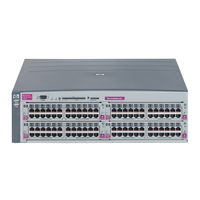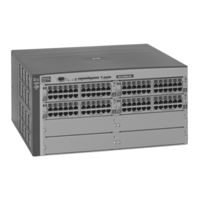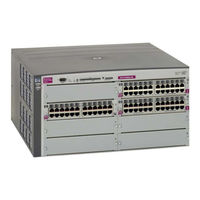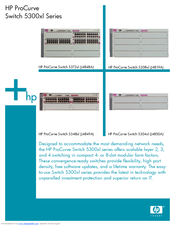HP ProCurve 5304xl Manuals
Manuals and User Guides for HP ProCurve 5304xl. We have 4 HP ProCurve 5304xl manuals available for free PDF download: Management Manual, Installation And Getting Started Manual, Reviewer's Manual, Specifications
HP ProCurve 5304xl Management Manual (664 pages)
Advanced Traffic
Table of Contents
-
Conventions24
-
Overview24
-
Keys26
-
Contents31
-
Overview32
-
Introduction33
-
Terminology35
-
Correct It49
-
Parameters57
-
Preparation76
-
Voice Vlans79
-
Port Trunks82
-
Switches83
-
Overview86
-
Introduction87
-
Overview106
-
IGMP Terms108
-
Contents127
-
Overview128
-
Introduction129
-
Feature Overview130
-
PIM-DM Operation130
-
Terminology135
-
Operating Notes160
-
Troubleshooting162
-
Applicable Rfcs166
-
Contents169
-
Overview170
-
RSTP (802.1W)174
-
Stp (802.1D)174
-
Overview177
-
Configuring RSTP179
-
STP Fast Mode196
-
Terminology199
-
Operating Notes210
-
MSTP Structure213
-
MST Regions215
-
Terminology218
-
Operating Rules220
-
Operating Notes246
-
Troubleshooting246
-
Switch Meshing247
-
-
Contents247
-
Introduction248
-
Terminology250
-
Operating Rules251
-
Preparation257
-
Flooded Traffic264
-
Static Vlans269
-
Dynamic Vlans270
-
Contents275
-
Introduction276
-
Terminology279
-
Overview280
-
Switches290
-
Switches291
-
Switches293
-
No Override297
-
Number299
-
Number300
-
Contents347
-
Introduction349
-
Terminology351
-
Types of IP Acls354
-
Overview354
-
ACL Operation358
-
Introduction358
-
Security363
-
Overview371
-
Types of Acls372
-
Interface377
-
Introduction413
-
Terminology416
-
Overview419
-
Types of IP Acls419
-
ACL Operation422
-
Standard Acls428
-
Extended Acls428
-
Security436
-
Types of Acls445
-
Overview445
-
Interface451
-
Contents487
-
IP Interfaces490
-
ARP Cache Table491
-
IP Route Table491
-
How ARP Works497
-
Configuring ICMP501
-
Configuring RIP507
-
Overview of RIP507
-
Enabling RIP509
-
Configuring OSPF520
-
Overview of OSPF520
-
Configuring OSPF524
-
Enabling OSPF526
-
Information550
-
Configuring IRDP556
-
Overview559
-
Overview562
-
Terminology574
-
Configuring XRRP583
-
Contents599
-
6400Cl Switches599
-
General Rules604
-
Specific Rules605
-
Commander Switch610
-
Stacking610
-
Stacking614
-
Status Messages642
Advertisement
HP ProCurve 5304xl Installation And Getting Started Manual (108 pages)
ProCurve Series 5300xl Switches
Table of Contents
-
-
-
Summary23
-
-
LED Behavior33
-
-
-
-
J9003A)57
-
-
-
Switch Ports77
-
Twisted Pair77
-
Fiber-Optic77
-
Cables78
-
-
-
HP ProCurve 5304xl Reviewer's Manual (35 pages)
ProCurve 5300xl Series
Table of Contents
-
-
Architecture11
-
Security19
-
Availability28
-
Hot Swap28
-
Dual Flash28
-
Alert Log28
-
Advertisement
HP ProCurve 5304xl Specifications (4 pages)
ProCurve 5300xl Series
Advertisement



